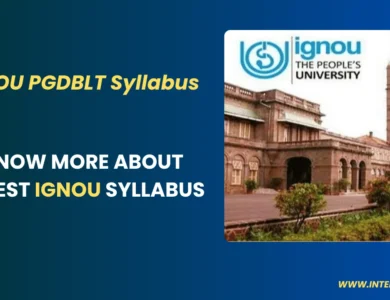IGNOU PGDGM Syllabus 2025

Are you planning to pursue a Post Graduate Diploma in Geriatric Medicine (PGDGM) from IGNOU in 2025? If so, understanding the complete syllabus structure, credit requirements, and learning methodology is crucial. IGNOU’s PGDGM program is a well-structured course aimed at medical professionals and fresh graduates who are looking to specialize in the care and treatment of elderly patients. With the rise in geriatric populations across the globe, this program becomes even more significant. The syllabus for 2025 has been updated to meet the current industry standards, providing students with a blend of theoretical and clinical exposure.
In this comprehensive guide, you’ll find everything you need to know about the IGNOU PGDGM syllabus 2025. From course structure and credit distribution to practical requirements and frequently asked questions, this article will serve as your go-to resource for academic planning.
Overview of IGNOU PGDGM Syllabus 2025
| Name of the Program | Post Graduate Diploma in Geriatric Medicine |
|---|---|
| Exam System | Annual |
| Total Credits | 36 |
| Program Category | IGNOU PGDGM |
The PGDGM program is designed to be completed in one academic year and comprises 36 credits. These credits are distributed among several courses, including both theoretical and clinical components. The annual examination system means students appear for exams once a year, making it easier for working professionals to balance study and practice.
IGNOU PGDGM Current Syllabus 2025: Course-Wise Breakdown
Below is a detailed breakdown of the current syllabus with course codes and respective credit allocations:
| Course Code | Name of the Course | Credits |
| MME 104 | Basic Geriatrics | 6 |
| MME 105 | Clinical Geriatrics I | 4 |
| MME 106 | Clinical Geriatrics II | 4 |
| MME 104 | Basic Geriatrics | 6 |
| MME 105 | Clinical Geriatrics I | 12 |
| MME 106 | Orthopaedics | 4 |
| Total Credits | 36 |
Note: The repetition in course codes and course names could indicate multiple assessment stages or practical components under the same subject area. Always confirm with the latest official syllabus from IGNOU.
Understanding the IGNOU PGDGM Credit System
IGNOU follows a modular credit-based evaluation system, which allows students to complete specific units of learning at their own pace. Here’s how the credit system works for the PGDGM program:
- Each credit is equivalent to approximately 30 hours of study, including reading, assignments, and practical work.
- Total Credits Required: 36
- Course Types: Core subjects with possible elective options depending on the academic session.
- Assessment: A combination of assignments, practicals, and term-end exams.
Advantages of Credit-Based Learning:
- Flexibility to study alongside professional commitments.
- Manageable workload spread across the academic year.
- Easier tracking of progress.
- Encourages independent learning.
Why Choose PGDGM at IGNOU?
The Post Graduate Diploma in Geriatric Medicine is particularly suited for MBBS graduates, general physicians, and healthcare professionals aiming to enhance their expertise in elder care. This is especially important in a country like India, where the aging population is rapidly increasing.
Key Benefits:
- Developed by renowned faculty and subject matter experts.
- Cost-effective and accessible nationwide.
- Flexible distance learning model.
- Clinical focus with potential hospital tie-ups for practical training.
- Boosts employability in hospitals, community health centers, and old-age homes.
Latest Updates to the PGDGM Syllabus Structure
To keep pace with medical advancements and the evolving needs of geriatric care, IGNOU updates its PGDGM syllabus regularly. The 2025 syllabus includes refreshed modules, updated clinical procedures, and revised reading materials.
What’s New in 2025?
- Enhanced modules on dementia care, palliative treatment, and chronic disease management.
- Greater emphasis on patient-centered care.
- Integration of telemedicine practices where applicable.
- Introduction to digital health records and monitoring tools for aged patients.
These changes are designed to ensure that students graduate with skills that are both contemporary and practically useful.
How to Use the Syllabus for Better Academic Planning
Success in the PGDGM program depends significantly on how well you manage your time and academic workload. Here are some tips:
- Plan Course Load Wisely: Divide your study schedule based on credit values. Courses with higher credits will need more attention.
- Follow Assignment Deadlines: IGNOU’s internal assessment relies heavily on assignments. Submitting them on time ensures you’re eligible for exams.
- Attend Practicals if Applicable: Some courses may include clinical requirements. If these are mandatory, make sure to coordinate with your regional center for hospital postings.
- Use Official Study Material: Rely on the latest IGNOU books and eGyanKosh platform for accurate content.
Common Career Paths After PGDGM
Upon successful completion of the PGDGM program, students can explore a range of professional roles in the healthcare sector:
- Geriatric Physician
- Healthcare Consultant for Aged Care
- Clinical Research Associate
- Community Health Officer
- Medical Officer in NGOs or Senior Living Homes
The qualification not only enhances clinical knowledge but also opens doors to impactful careers in elder healthcare services.
FAQs on IGNOU PGDGM Syllabus 2025
Q1. Is there any practical or hospital-based training in PGDGM?
Yes, particularly in Clinical Geriatrics courses, students may be required to attend hospital-based training or submit practical reports.
Q2. Can I complete the PGDGM program in one year?
Yes, the program is structured to be completed within one academic year, provided you meet all academic and practical requirements.
Q3. What is the eligibility for the PGDGM program?
Applicants must hold an MBBS degree or an equivalent medical qualification from a recognized university.
Q4. Are there elective subjects in the program?
Generally, the program focuses on core areas of geriatrics, but IGNOU may offer optional subjects based on student demand and session availability.
Q5. How do I get the study material?
IGNOU provides printed materials via post and digital copies through its eGyanKosh portal after admission confirmation.
Q6. Is PGDGM recognized by medical councils?
Yes, IGNOU is a central university and its programs, including PGDGM, are widely recognized. However, always verify with specific state or national medical bodies for registration-related queries.
For the most accurate and updated syllabus, always refer to the official IGNOU website or consult your regional study center. Staying informed and proactively planning your studies can make your PGDGM journey more rewarding and impactful.







